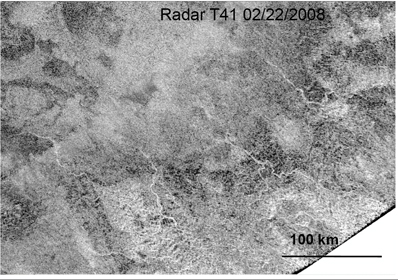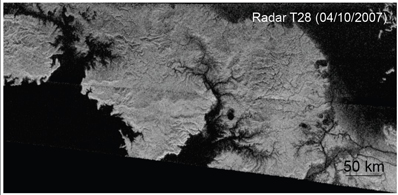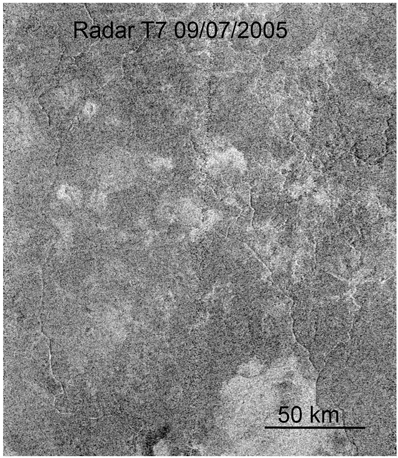


|

|
 |
|
Titan's wet north pole KEITH COOPER ASTRONOMY NOW Posted: September 16, 2009 A more global view of the landscape on Saturn’s moon Titan shows the extent of the river channels, lakes, continents and vast plains of dunes that cover its surface. The new maps, courtesy of the radar instrument on NASA’s Cassini spacecraft, are being presented today at the European Planetary Science Congress (EPSC) in Potsdam by scientists from the German Aerospace Centre (DLR).  A radar image taken of a region close to Titan's equator, showing large valleys. Image: Cassini Radar Team/ESA/NASA/JPL.
A radar image taken of a region close to Titan's equator, showing large valleys. Image: Cassini Radar Team/ESA/NASA/JPL.
The only way to see down to Titan’s freezing surface (where chemical reactions occur at –179 degrees Celsius) through its thick nitrogen atmosphere and hydrocarbon smog, is to use either radar or near-infrared wavelengths. In radar images smoother areas, such as rivers and lakes, appear black.  Large and striking rivers and lakes (in black) cover Titan's northern hemisphere in this radar image of near the north pole. Image: Cassini Radar Team/ESA/NASA/JPL.
Large and striking rivers and lakes (in black) cover Titan's northern hemisphere in this radar image of near the north pole. Image: Cassini Radar Team/ESA/NASA/JPL.
The new maps show Titan’s northern hemisphere covered in river channels and lakes, but unlike on Earth they are not made from liquid water, but liquid hydrocarbons such as methane and ethane. It is currently summer in Titan’s northern hemisphere, and rain clouds gather close to the north pole releasing a sleet of methane rain that runs down from continental highlands into lakes. In contrast, near the south pole where winter is approaching, barely any river channels could be seen.  By stark contrast, the southern polar region is much barer than the north. Image: Cassini Radar Team/ESA/NASA/JPL.
By stark contrast, the southern polar region is much barer than the north. Image: Cassini Radar Team/ESA/NASA/JPL.
“The observations of the extensive river structures at the north pole have led us to a fascinating conclusion: there must be heavy and frequent rain of liquid hydrocarbons,” says DLR’s Mirjam Langhans, who is presenting the new results at EPSC. Meanwhile, at Titan’s equator, highlands and large plains of dunes of ice crystals, blown by east–west winds cover the land, with dark spots littered here and there that could be short-lived lakes from ‘tropical storms’ (such as the one reported here last month), each one linked by large valleys that could support rivers. |
|
|
|
|